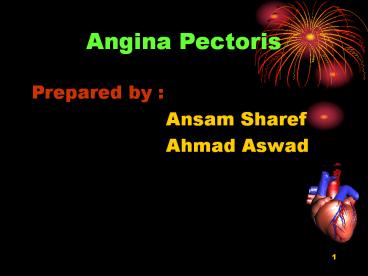Angina Pectoris - PowerPoint PPT Presentation
Title:
Angina Pectoris
Description:
* Type of angina Variant angina or prinzmetals angina : pain at rest with reversable ST-segment elevation, caused by coronary artery vasospasm. – PowerPoint PPT presentation
Number of Views:6663
Avg rating:3.0/5.0
Title: Angina Pectoris
1
Angina Pectoris
- Prepared by
- Ansam Sharef
- Ahmad Aswad
2
Angina Pectoris
- Definition
- Angina pectoris is a clinical syndrome usually
characterized by episodes of pain or pressure in
the anterior chest . The cause is usually
insufficient coronary blood flow which results in
a decreased oxygen supply to meet an increased
myocardial demand for oxygen in response to
physical exertion or emotional stress.
3
Pathophysiology
- Myocardial ischemia can result from
- A reduction of coronary blood flow caused by
fixed \or dynamic epicardial artery stenosis. - Abnormal constriction or deficient relaxation of
coronary artery. - Reduce O2-carrying capacity of the blood .
4
(No Transcript)
5
Factors are associated with typical angina pain
- Physical exertion (increase myocardial o2
demand). - Exposure to cold ( cause elevation of BP increase
oxygen demand ) - Eating heavy meals
- Stress or any emotion-provoking situation
6
Type of angina
- Stable angina predictable consistent pain that
occurs on exertion and relieved by rest. - Unstable angina or preinfarction or cresendo
angina symptoms occur more frequently and longer
than stable angina. - Intractable or refractory angina sever
incapacitating chest pain.
7
Type of angina
- Variant angina or prinzmetals angina pain at
rest with reversable ST-segment elevation, caused
by coronary artery vasospasm. - Silent ischemia objective evidence of ischemia
(as ECG changes with a test), but pt report no
symptom.
8
Risk Factors for atherosclerosis
- Family history of premature coronary artery
disease. - DM, systemic HTN.
- Cigarette smoking.
- Hypercholesterolemia.
- Others as obesity, increase levels of
lipoprotein,fibrinogen, s.triglycerides.
9
Clinical manifestations
- May produce pain vary in severity from feeling
of indigestion to chocking in retrosternal area ,
radiate to neck , jaw shoulders , inner aspects
of upper arms - Feeling of weakness or numbness in the arms ,
wrists and the hands - Shortness of breath
10
Clinical manifestations
- Pallor, Diaphoresis
- Dizziness or lightheadedness
- Nausea and vomiting
11
Diagnostic findings
- Often made by evaluating the clinical
manifestations of ischemia and the pts history - 12-Lead ECG and blood laboratory
values help in making diagnosis - C-reactive protein ( CRP) is a marker for
inflammation of vascular endothelium which caused
by CAD
12
(No Transcript)
13
Diagnostic findings
- An elevated blood level of homocysteine ,an amino
acid proposed as an independent risk
factor for cardiovascular disease , but no
studies supported the relationship between
elevation of homocysteine and
atherosclarosis
14
Medical management for the pt with angina pectoris
15
- The objective is to decrease oxygen demand of
myocardium and to increase oxygen supply - 1.Nitroglycerin administered to reduce
myocardial oxygen consumption
16
- 2.Beta-adrenergic blocking agents
- ( propranolol ,metoprolol , atenolol) appear
to reduce myocardial oxygen consumption, result
in a reduction in heart rate, decreased BP , and
reduced myocardial contractility .
17
- 3-Calcium channel blocking agents some decrease
sinoatrial node automaticity and node conduction
,resulting in slower heart rate
18
4- Antiplatelet and anticoagulent medications
- Aspirin prevents platelet activation and
reduces the incidence of MI and death with CAD - Heparin prevents the formation of new blood
clots
19
- Oxygen administration
- usually initiated at the onset of chest
pain to increase the amount of oxygen delivered
to the myocardium and to decrease the pain.
20
Prevention
- Self care action plan changing habits.
- Stop smoking
- Increase level of exercise
- Cut down on fatty foods
- Eat more oats, which decrease cholesterol
21
- Lose wt if u DR. thinks you are overweight.
- Make sure your BP is not high by regular check
- Consider another method of contraceptive if you
take pill
22
Nsg process for pt with Angina pectoris
- Assessment
- The nurse gather information about the pts
symptoms and activities . The nurse may ask about
the period that angina last , and if any
medication relieve the angina.
23
Diagnosis
- Ineffective myocardial tissue
- perfusion secondary to CAD as
- evidence by chest pain or equivalent
- symptoms
- Anxiety related to fear of death
24
Diagnosis
- Noncompliance , ineffective management of
therapeutic regimen related to failure to
accept necessary lifestyle changes
25
Planning and goals
- The major goal include immediate treatment when
angina occur , preventing of angina , reduction
of anxiety and absence of complications
26
NSG interventions
- Treating angina when pt experiences angina the
nurse should direct pt to stop activities and sit
or rest in bed in semi-fowler position - Reducing anxiety The nurse should explore and
implicate that the diagnosis has for the pt
providing information about the illness ,
treatment and methods of preventing its
progression
27
- Preventing pain when the pt has pain with
minimal activity , the nurse alternates the pts
activities with rest periods
28
Evaluation
- expected pts outcomes may include
- Reports that pain is relieved promptly
- Reports decreased anxiety
29
- Understands ways to avoid complications and
demonstrates freedom from complications - Adheres to self-care program
30
THANK YOU































